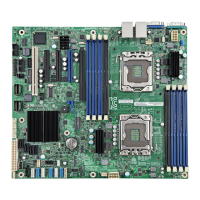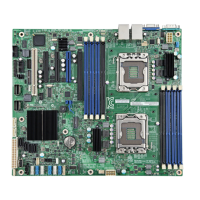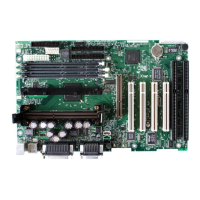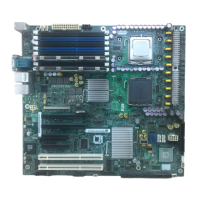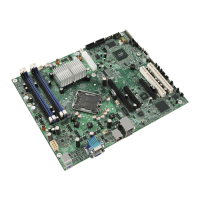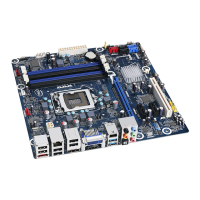Intel® Server Board S2600IP and Intel® Workstation Board W2600CR TPS Functional Architecture
Revision 1.1 31
Intel order number G34153-003
QR RDIMMs may only be installed in DIMM Slot 1 or 2 on a channel.
2 DPC QR Low Voltage RDIMMs are not supported.
In order to install 3 QR LRDIMMs on the same channel, they must be operated with
Rank Multiplication as RM = 2.
RAS Modes Lockstep, Rank Sparing, and Mirroring are mutually exclusive in this BIOS.
Only one operating mode may be selected, and it will be applied to the entire system.
If a RAS Mode has been configured, and the memory population will not support it
during boot, the system will fall back to Independent Channel Mode and log and display
errors
Rank Sparing Mode is only possible when all channels that are populated with memory
meet the requirement of having at least 2 SR or DR DIMM installed, or at least one QR
DIMM installed, on each populated channel.
Lockstep or Mirroring Modes require that for any channel pair that is populated with
memory, the memory population on both channels of the pair must be identically sized.
DIMM population rules require that DIMMs within a channel be populated starting with the BLUE
DIMM slot or DIMM farthest from the processor in a “fill-farthest” approach. In addition, when
populating a Quad-rank DIMM with a Single- or Dual-rank DIMM in the same channel, the
Quad-rank DIMM must be populated farthest from the processor. Note that Quad-rand DIMMs
and UDIMMs are not allowed in three slots populated configurations. Intel MRC will check for
correct DIMM placement.
3.2.2.3 Publishing System Memory
The BIOS displays the “Total Memory” of the system during POST if Display Logo is
disabled in the BIOS setup. This is the total size of memory discovered by the BIOS
during POST, and is the sum of the individual sizes of installed DDR3 DIMMs in the
system.
The BIOS displays the “Effective Memory” of the system in the BIOS setup. The term
Effective Memory refers to the total size of all DDR3 DIMMs that are active (not
disabled) and not used as redundant units.
The BIOS provides the total memory of the system in the main page of the BIOS setup.
This total is the same as the amount described by the first bullet above.
If Quite Boot is disabled, the BIOS displays the total system memory on the diagnostic screen at
the end of POST. This total is the same as the amount described by the first bullet above.
3.2.2.4 RAS Features
The server board supports the following memory RAS modes:
Independent Channel Mode
Rank Sparing Mode
Mirrored Channel Mode
Lockstep Channel Mode
Regardless of RAS mode, the requirements for populating within a channel given in the section
3.2.2.2 must be met at all times. Note that support of RAS modes that require matching DIMM
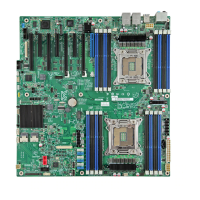
